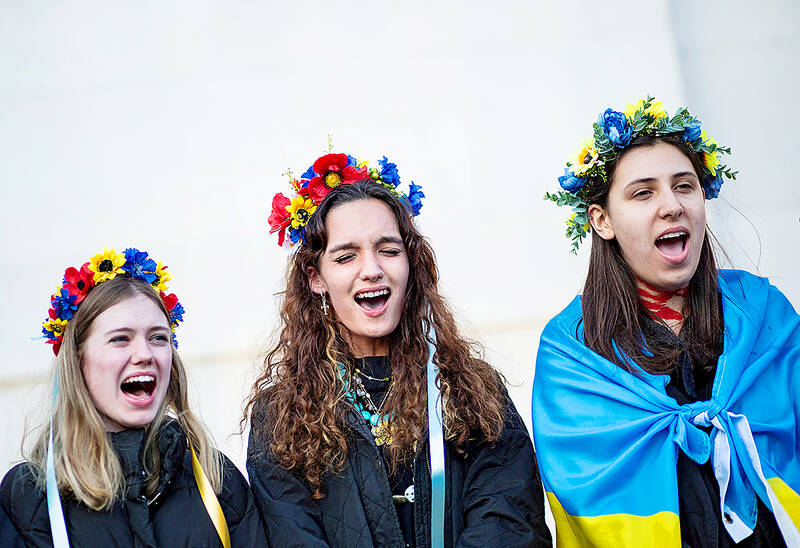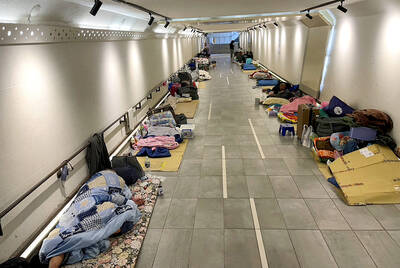Exhausted and overwhelmed, Gretchen Miller felt the frustration of the past three years rise up within her. On a whim the 54-year-old from Sydney, Australia posted a message to her local community Facebook group. “Does anyone else feel like screaming?” she asked.
The responses poured in.
“I want to scream because of climate change and economic inequality,” one woman wrote. “Because of real estate agents and landlords,” said another. “My fiance decided he didn’t love me anymore,” read one reply.

Photo: AFP
Miller said she received more than 100 messages in the first hour.
From that callout, the Shout Sisters group was formed. A month later they met for the first time at an inner city park to bellow their frustrations into the Australian night.
In recent months, women-only “scream groups” like Miller’s have cropped up all over the world. Frustration, pandemic exhaustion and the pressures of life are common reasons women say they take part. Most are drawn to the idea of unleashing their anger without inhibition. It’s a freedom participants say is hard to find in a world that can be uncomfortable with women’s rage.
“Women want to scream,” Miller explains. “There are plenty of spaces for men to yell [but] we don’t often get to raise our voices [and] when we do we’re met with disapproval.”
‘WILD AND FUN’
On a Wednesday evening in Sydney, women begin to emerge — one by one — through the trees, ambling along the footpath until they reach the agreed meeting point.
A few nervous exchanges set the scene. A handful of joggers brush past as a college football team slowly disbands for the night.
“After the week of hell I’ve had I need a good scream!” Maryanne Lia, 45, a self-described “screamstress” and mother of four, jokes to the dozen strangers gathered in the park. A chorus of chuckles and smiles nod back in agreement.
A countdown sets the scream in motion. “Three. Two. One!” Twelve unbridled voices pierce the quiet of the night, roar around the hills and then disappear into the passing traffic below. They scream again. Grasping their knees, some shaking their hair, in a circle and some howling at the moon.
“I feel like a little bit of magic just happened,” Miller says as the group lies back on the grass, staring at the stars.
Lia agrees. “It’s the freedom to do something wild and fun … to let it all go in a mighty roar.”
One of the first groups to attract attention was in the US, in Boston, during the COVID pandemic lockdowns last year. Sarah Harmon, a therapist, yoga teacher and mother of two, sparked a nationwide call to action when she and a group of 20 women turned up to their local football field in Charlestown to scream into the crisp evening air.
“It felt good to be able to be out of control,” one participant said of the event. Another said: “It’s the closest I have come to finding a coven.”
In Asia, kindred rebellions are taking place. Deepika, 27, has mobilized a small but dogged taskforce of women across New Delhi who want to feel safe in a city grappling with a plague of violence against women and girls.
“There is a theme in India of keeping women silent,” she explains. “This is my small way of saying ‘no, we are here, we have something to say and you’re going to hear it.’”
Deepika says the group helps challenge the idea that women’s anger should remain hidden.
“Why is anger seen as such a dangerous emotion in women?” she asks. “We have things to be angry about but if we express it we’re seen as crazy or hysterical or out of control.”
Her scream group has nearly 150 members and many gather in locations across India’s capital.
“It’s therapeutic. It’s a sort of collective self-care,” Deepika says.
‘NO JUDGEMENT, NO SHAME’
Dr Miriam Yates, an organizational psychologist and research fellow at the Institute for Social Science Research at the University of Queensland, says that anger and rage can be seen as undesirable or even unnatural for women.
“We expect that women are kind, caring, warm and cooperative. Anger or indeed, rage, is inconsistent with these expectations,” she explains.
Back in Sydney, Lia shares similar sentiments about what it means to be female and furious in a world that has largely placed limits on women’s anger.
“There’s an actual proper rage and women don’t get to express it. Where can you release that? Where can you scream?
“You can’t scream at your boss, you can’t scream at your children. I’ll scream in the car but where else can you do it?” Lia asks.
Earlier this year and a week into one of China’s strictest COVID lockdowns so far, a video of Shanghai residents living inside a densely packed apartment building screaming in unison from their balconies went viral online.
One woman said screaming helped ease the frustration of being locked indoors. Her neighbors joined the chorus after hearing her shrieks through their apartment walls.
Women have experienced additional stresses with work, family and social demands over the past few years, Yates adds.
Screaming groups may provide “the opportunity to express that rage in a supported environment” without the negative consequences, she says.
Seizing upon a similar idea, Scottish-born Julie Scott runs Screech on the Beach from the Hague. It’s a morning ritual that starts in darkness and ends with a moment of meditation on the sand.
“I walk back through the dunes and I feel lighter,” she explains.
For Scott, “there is no judgment, there is no shame” in screaming into the sea. “For a brief moment our inhibitions are forgotten, we are together and everything is possible … it’s also a hell of a lot of fun.”

From the last quarter of 2001, research shows that real housing prices nearly tripled (before a 2012 law to enforce housing price registration, researchers tracked a few large real estate firms to estimate housing price behavior). Incomes have not kept pace, though this has not yet led to defaults. Instead, an increasing chunk of household income goes to mortgage payments. This suggests that even if incomes grow, the mortgage squeeze will still make voters feel like their paychecks won’t stretch to cover expenses. The housing price rises in the last two decades are now driving higher rents. The rental market

July 21 to July 27 If the “Taiwan Independence Association” (TIA) incident had happened four years earlier, it probably wouldn’t have caused much of an uproar. But the arrest of four young suspected independence activists in the early hours of May 9, 1991, sparked outrage, with many denouncing it as a return to the White Terror — a time when anyone could be detained for suspected seditious activity. Not only had martial law been lifted in 1987, just days earlier on May 1, the government had abolished the Temporary Provisions Effective During the Period of National Mobilization for Suppression of the Communist

When life gives you trees, make paper. That was one of the first thoughts to cross my mind as I explored what’s now called Chung Hsing Cultural and Creative Park (中興文化創意園區, CHCCP) in Yilan County’s Wujie Township (五結). Northeast Taiwan boasts an abundance of forest resources. Yilan County is home to both Taipingshan National Forest Recreation Area (太平山國家森林遊樂區) — by far the largest reserve of its kind in the country — and Makauy Ecological Park (馬告生態園區, see “Towering trees and a tranquil lake” in the May 13, 2022 edition of this newspaper). So it was inevitable that industrial-scale paper making would

Hualien lawmaker Fu Kun-chi (傅?萁) is the prime target of the recall campaigns. They want to bring him and everything he represents crashing down. This is an existential test for Fu and a critical symbolic test for the campaigners. It is also a crucial test for both the Chinese Nationalist Party (KMT) and a personal one for party Chairman Eric Chu (朱立倫). Why is Fu such a lightning rod? LOCAL LORD At the dawn of the 2020s, Fu, running as an independent candidate, beat incumbent Democratic Progressive Party (DPP) lawmaker Hsiao Bi-khim (蕭美琴) and a KMT candidate to return to the legislature representing